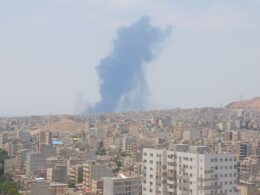Iranian state-run outlet Nour News Agency reported that Russian National Security Council Secretary Nikolai Patrushev arrived in Tehran on November 8, likely to discuss the potential sale of Iranian ballistic missiles to Russia
.
Nour News Agency announced Patrushev’s arrival in an English-language tweet, stating that Iranian Supreme National Security Council (SNSC) Secretary Ali Shamkhani invited Patrushev and noted that Patrushev will also meet with other high-ranking Iranian political and economic officials to discuss Russo-Iranian cooperation.
Nour News Agency is affiliated with the SNSC. The SNSC likely announced Patrushev’s arrival in Iran to highlight the deepening cooperation between Moscow and Tehran to an international audience (rather than domestically), as well as to implicitly highlight that a high-ranking Russian official turned to Iran for help in Ukraine. Islamic Revolutionary Guards Corps (IRGC) Quds Force Commander Qassem Soleimani notably traveled to Moscow in 2015 to appeal
to Russia to intervene in the Syrian Civil War.
Tehran is likely eager to publicly signal this rebalancing of its strategic partnership with Moscow, especially to regional Iranian adversaries with which the Kremlin occasionally cooperates, such as Israel and Saudi Arabia.
Patrushev’s visit to Iran notably comes amid reports that the Iranian regime is seeking Russian help with protest suppression, although it is unclear if this will be discussed by Patrushev and his Iranian counterpart.
The Kremlin is continuing efforts to covertly acquire munitions for use in Ukraine to mitigate the effects of international sanctions and backfill Russia’s ongoing depletion of domestic munitions stockpiles. British outlet Sky News reported on November 8 that the Kremlin flew 140 million euros in cash and a selection of captured British-made NLAW anti-tank missiles, US-made Javelin anti-tank missiles, and a Stinger anti-aircraft missile to Tehran on August 20 in exchange for 160 additional Shahed-136 drones for use in Ukraine.
The Ukrainian Resistance Center reported
on November 8 that Tehran continues to supply Moscow with Mohajer, Arash, and Shahed-type drones by air and sea via both Iranian state-owned and privately-owned entities. The Ukrainian Resistance Center additionally reported that due to failures of the Russian military-industrial complex, Russian military leaders are continuing their efforts to procure dual-use (military and non-military use) goods such as computer chips, quadcopters, night vision devices, and bulletproof vests from Türkiye and are using cryptocurrency transactions to avoid purchase tracking.
Russia attacked Dnipro with kamikaze drones injuring four – oblast authorities




